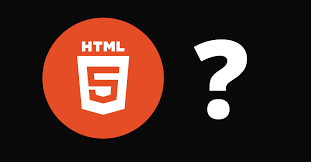হাইপার টেক্সট মার্কআপ ল্যাঙ্গুয়েজ (অথবা এইচটিএমএল, ইংরেজি: Hyper Text Markup Language) হলো একটি মার্ক আপ ল্যাঙ্গুয়েজ। এইচটিএমএল এর মার্ক আপ ট্যাগ সমূহ ব্যবহার করে ওয়েবপেজ এর বেসিক কাঠামো তৈরি করা হয়।
Sure! I can help you learn HTML. HTML stands for HyperText Markup Language, and it is the standard markup language for creating web pages. It uses a set of tags and attributes to structure and present the content on a webpage. Here's a basic introduction to HTML:
HTML Structure: HTML documents are made up of elements that are enclosed in tags. The basic structure of an HTML document is as follows:
l><!DOCTYPE html><html><head> <title>Title of the Webpage</title></head><body> <!-- Content goes here --></body></html>
<!DOCTYPE html>: This declaration specifies the version of HTML being used (HTML5 in this case).<html>: This is the root element and encapsulates the entire HTML document.<head>: This section contains meta information about the document, such as the title, stylesheets, scripts, etc.<title>: This tag specifies the title of the webpage, which is displayed in the browser's title bar or tab.<body>: This section contains the visible content of the webpage.
HTML Tags: HTML tags are used to mark up different parts of the content. Here are a few commonly used tags:
<h1>to<h6>: These tags define headings of different levels, with<h1>being the highest level and<h6>the lowest.<p>: This tag is used to define paragraphs.<a>: This tag is used to create links. Thehrefattribute specifies the URL of the link.<img>: This tag is used to insert images. Thesrcattribute specifies the image URL.<ul>and<li>: These tags are used to create unordered lists.<ul>represents the list container, and<li>represents individual list items.<ol>and<li>: These tags are used to create ordered lists.<ol>represents the list container, and<li>represents individual list items.<div>: This tag is used to group elements together or create sections on a webpage.
Attributes: HTML tags can have attributes that provide additional information about the element. Here are a few examples:
class: Used to specify a CSS class for an element.id: Used to specify a unique identifier for an element.style: Used to apply inline CSS styles to an element.src: Used to specify the source URL of an image or media file.href: Used to specify the destination URL of a link.
Here's an example of a simple HTML document that uses some of these tags and attributes:
html<!DOCTYPE html>
<html> <head>
<title>My First Webpage</title>
</head> <body>
<h1>Welcome to My Webpage!</h1>
<p>This is a paragraph of text.</p>
<a href="https://www.example.com">Click here</a> to visit Example.com.
<img src="image.jpg" alt="A beautiful image">
<ul>
<li>Item 1</li>
<li>Item 2</li>
<li>Item 3</li>
</ul>
<div class="container">
<h2>This is a section</h2>
<p>Some content goes here...</p>
</div>
</body> </html>
This is just a brief introduction to HTML. There's a lot more you can do with HTML, including tables, forms, multimedia, and more. I recommend referring to online resources and tutorials to explore HTML further and learn about its various features and capabilities.













0 Comments